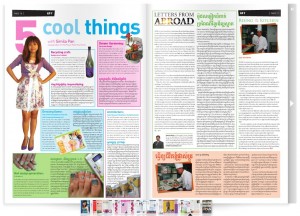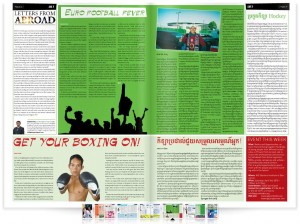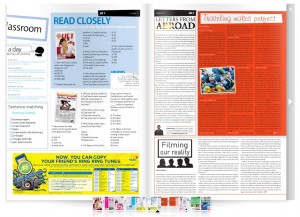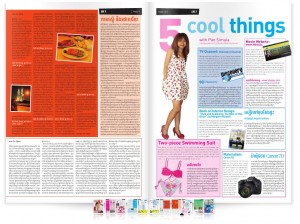Tourism
now browsing by category
Khmer Stylizing in Canada
Wednesday, 07 April 2010 15:00 Sophan Seng

April is a busy month for Cambodians all over the Khmer diaspora since Khmer New Year is fast approaching. Since the holiday is not recognised by governments in foreign countries, Cambodians living abroad must wait for the weekend to celebrate the holiday. Some communities celebrate the holiday at Buddhist temples, but more often than not, people celebrate the new year in public halls or other rented spaces.
While the location of the celebration may not be familiar to many Cambodians, the events themselves have changed little among Cambodians living abroad. Go to a Khmer New Year celebration in Canada and you are likely to see authentic food, religious ceremonies, popular games, and traditional arts and entertainment.
The thing that always impresses me most is the beauty of the women wearing traditional Khmer outfits. The graceful appearance of Khmer women and their styles of dress have remained intact. “I have always worn traditional Khmer outfits to attend Khmer festivals, wedding ceremonies and traditional gatherings,” said Kimleine, who has been living away from Cambodia since she was a toddler.
I would say that every Khmer family I know has plenty of traditional clothes for such events. Peddlers display different styles of Khmer cloths every time a cultural event is upcoming.
“I like the style a lot, especially Khmer traditional outfits for weddings,” said Kimleine.
Read More …
Posted in Culture, Education, Social, Tourism | 5 Comments »
Hocky battling in Canada
Letters from abroad
 Just few weeks ago, Canadians were proudly cheering on their team as they celebrated Canada’s gold-medal hockey win over America in the 2010 Olympic winter games held in Vancouver. Days afterwards, the National Hockey League (NHL) resumed its regular season, and in April the league will begin its own championship tournament. There are 32 hockey teams in the NHL who represent 32 cities with their hockey-playing prowess.
Just few weeks ago, Canadians were proudly cheering on their team as they celebrated Canada’s gold-medal hockey win over America in the 2010 Olympic winter games held in Vancouver. Days afterwards, the National Hockey League (NHL) resumed its regular season, and in April the league will begin its own championship tournament. There are 32 hockey teams in the NHL who represent 32 cities with their hockey-playing prowess.
The league is divided into 16 teams on the West Coast and 16 teams on the East Coast. Canada has six teams in the East Coast league, with the other 26 teams coming from America. The playoffs are the grand finale of the season, where eight teams from each side of the continent play each other for the Stanley Cup, a trophy that is given to the league’s best team each year.
“I am cheering for the Calgary Flames to reach the playoffs,” said Kevin Troung, who is an 18-year-old fan of the Canadian hockey team. “They are currently battling with the Red Wings of Detroit to get a chance to enter the Stanley Cup finals.”
While football is the most popular sport in Cambodia, hockey is without a doubt the most popular sport in Canada, and the two games have many differences. In football, the players run around on the green grass wearing nothing but shin pads to protect themselves from injury. Hockey players, on the other hand, are equipped with helmets, padding and a stick that they use to move the puck (like a flattened ball) around the ice while they move around on their skates like hurricanes. Each side is composed of six players: three forwards who attempt to hit the puck into the opponent’s small goal, and two defenders and a goalie who try to stop the other team from scoring. Like soccer, the winner is the team that scores the most goals.
Read More …
Posted in Economics, Internet, Social, Tourism | 5 Comments »
Letter from Abroad: Struggling Life
 It’s February in Canada and the temperature is below the freezing point. The people are shaking in the cold, harsh winter wind and the ground is entirely covered by a thick layer of white ice. Pheak Kdey, who is 30-years-old, drives his BMW through the blistering cold every day to work at his gas station. But today, he is taking time to join a meeting with other ethnic Cambodians to discuss their action plan for 2010.
It’s February in Canada and the temperature is below the freezing point. The people are shaking in the cold, harsh winter wind and the ground is entirely covered by a thick layer of white ice. Pheak Kdey, who is 30-years-old, drives his BMW through the blistering cold every day to work at his gas station. But today, he is taking time to join a meeting with other ethnic Cambodians to discuss their action plan for 2010.
The six-strong Khmer Youth Association of Alberta has contributed substantially to its community since it was founded in 1994 in Calgary, a sprawling city in western Canada. Pheak Kdey, who migrated from a border camp in 1983 during the civil war in Cambodia, was raised and educated here, and now runs a family business.
Pheak Kdey is one of many young Cambodians who have grown up in a foreign country, and he said that this hasn’t always been easy. “My parents had a difficult time adapting to a new life in an unfamiliar culture, surrounded by people speaking a foreign language,” he said. “But I enjoyed making new friends at school, and I became a coordinator between my parents and other people in our community.” After graduating from high school, Pheak Kdey began working at a gas station and seven years later, he was the station’s owner.
Read More …
Posted in Culture, Education, Social, Tourism | 2 Comments »
CAMBODIA: MEMORY, ATROCITY AND AFFECT
POLS 703
CAMBODIA: MEMORY, ATROCITY AND AFFECT
by Alvin Lim
In 2005, just as America was reeling from the effects of Hurricane Katrina, I embarked on a line
of flight from a quotidian life in Singapore, arriving in Phnom Penh to begin a new career as a
philosophy lecturer at Pannasastra University. Several months earlier I had resigned from my
excruciating human resources job at Singapore Airlines. So, it was as a Singaporean suffering
from ennui that I encountered several sites of memory of atrocity in Cambodia, some of which I
shall discuss in this essay. The organization of this paper is not what Gilles Deleuze and Félix
Guattari (1987) would describe as aborescent, but is instead rhizomatic – its nodes crystallize
encounters I have and have not had with collective memories of atrocity (p. 21). This exploration
transverses time and space, and explores the political significance of sensory affects ranging
from the visual to the gustatory.
A Visit to Tuol Sleng
Under Pol Pot, the Tuol Svay Prey High School was transformed into S-21, the core of
Democratic Kampuchea’s internal surveillance and disciplinary apparatus. The former high
school’s classrooms were crudely transformed and deployed as prison cells and torture
chambers. During the Vietnamese occupation, S-21 was transformed into a genocide museum,
which has since become one of Phnom Penh’s most popular tourist destinations.
Any visit to a memory site of atrocity raises the question of visitor’s ambiguous identity as a
witness to the past or as a voyeur of the other’s pain. Philip Gourevitch (1998) confronted this
dilemma when he visited Rwanda’s Nyarubuye genocide memorial, where the murdered victims
were left unburied as a potent means of commemoration of their atrocious ends:
The dead at Nyarubuye were, I’m afraid, beautiful. There was no getting around it. The
skeleton is a beautiful thing. The randomness of the fallen forms, the strange tranquility
of their rude exposure, the skull here, the arm bent in some uninterpretable gesture there
– these things were beautiful, and their beauty only added to the affront of the place. I
couldn’t settle on any meaningful response: revulsion, alarm, sorrow, grief, shame,
incomprehension, sure, but nothing truly meaningful. I just looked, and I took
photographs, because I wondered whether I could really see what I was seeing while I
saw it, and I wanted also an excuse to look a bit more closely (p. 19).
Sven Lindqvist (1992), another explorer of historical pain, connects memory sites of atrocity to
the European project of colonialism. Noting that the Victorian liberal theorist Herbert Spenser
had applauded the extermination of those troublesome human populations that stood in the way
of the civilizing projects of Western colonialism (pp. 8-9), Lindqvist observes that:
The idea of extermination lies no farther from the heart of humanism than Buchenwald
lies from the Goethehaus in Weimar. That insight has been completely repressed, even by
Germans, who have been made sole scapegoats for ideas of extermination that are
actually a common European heritage (p. 9).
Read More …
Posted in Education, Politics, Researches, Social, Tourism | Comments Off on CAMBODIA: MEMORY, ATROCITY AND AFFECT
Tags: Alvin Lim, Cambodia, Toul Sleng















